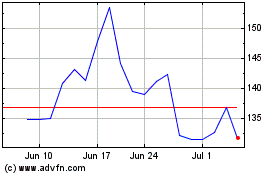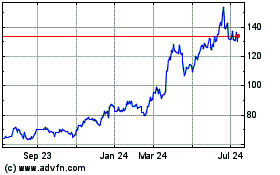Micron Technology, Inc. (Nasdaq: MU), today announced the world’s
fastest discrete graphics memory solution, GDDR6X, the first to
power system bandwidth up to 1 terabyte per second (TB/s). Working
with visual computing technology leader NVIDIA, Micron debuted
GDDR6X in the new NVIDIA® GeForce RTX™ 3090 and GeForce RTX 3080
graphics processing units (GPUs), which are tailored to support the
fast speeds that immersive, high-performance gaming applications
demand.
“Our multilevel signaling innovation in GDDR6X has shattered
conventional bandwidth limits, clocking record-breaking speeds,”
said Tom Eby, senior vice president and general manager of the
Compute & Networking Business Unit at Micron. “Unlike
traditional memory, GDDR6X has unparalleled data rates that can
keep pace with gaming innovation and data-hungry applications —
setting a new standard for graphics memory.”
Micron’s GDDR6X serves as a powerful enabler of NVIDIA GeForce
RTX 3090 and GeForce RTX 3080 graphics cards’ performance. Building
on its most recent collaboration with NVIDIA for the GeForce RTX
graphics card (enabled by GDDR6), Micron transforms the memory/GPU
interface with GDDR6X, accelerating performance on complex graphics
workloads across next-generation gaming applications.
“With the unprecedented speed of GDDR6X, Micron has delivered
tomorrow’s memory technology today, and it’s at the heart of NVIDIA
GeForce RTX 3090 and 3080 GPUs — helping us deliver rich,
realistic, cinematic user experiences,” said Jeff Fisher, senior
vice president of the GPU Business Unit at NVIDIA. “Building on a
history of collaboration that started with GDDR5, we’re thrilled to
have reinvented the memory/GPU interface with Micron, setting a new
bar for high-performance, high-resolution gaming.”
As PC gaming evolves in sophistication, gamers today demand the
highest performance for their advanced graphics cards — a requisite
for smooth animation, sharp visuals, 8K resolution and real-time
ray tracing, a rendering technique that results in realistic light
reflections and cinematic effects. GDDR6X’s groundbreaking speed
offers discerning gamers high-resolution experiences with maximum
frame rates and instant rendering, allowing users to experience
highly realistic and reactive effects without jarring lags.
Combined with NVIDIA’s GeForce RTX 3090 and GeForce RTX 3080 GPUs,
GDDR6X’s ultra-bandwidth capabilities improve real-time ray tracing
and neural graphics processing to create photorealistic and
immersive virtual worlds in PC games.
The new NVIDIA GeForce RTX 30 Series GPUs — the second
generation of the NVIDIA RTX PC gaming platform — feature new ray
tracing cores, Tensor Cores and streaming multiprocessors. The
results are stunning visuals, amazingly fast frame rates and
artificial intelligence acceleration for games and creative
applications. Powered by the NVIDIA Ampere architecture, which
delivers increases of up to 1.9 times performance-per-watt over the
previous generation, the RTX 30 Series effortlessly powers graphics
experiences at all resolutions, even up to 8K. The series
represents the greatest GPU generational leap in NVIDIA’s
history.
Beyond the Binary: First to Implement PAM4 in Memory,
Micron Sets New Benchmark
Micron achieved GDDR6X’s breakthrough bandwidth by applying
innovative signal transmission technology, four-level pulse
amplitude modulation (PAM4), to revolutionize how memory moves
data. Since 2006, Micron’s engineers and researchers have explored
applying multilevel signaling to the memory interface. Over 45
patents later, Micron is the first in the industry to implement
PAM4 in memory, creating a new benchmark for future generations of
graphics memory.
By using PAM4 multilevel signaling techniques, GDDR6X transfers
data much faster, doubling the input/output (I/O) data rate. Until
now, graphics memory was capped at 64 gigabytes per second (GB/s),
transmitting one bit per cycle through the traditional binary
standard, which relies on two signal levels to transmit data
encoded as 1s or 0s. Instead, Micron’s novel PAM4 technique employs
four distinct levels to transmit two bits of data to and from the
memory at a time. As a result, Micron’s GDDR6X dramatically
increases memory bandwidth to 84 GB/s for each component,
translating to system bandwidth of up to 1 TB/s — rates once
thought impossible.
Micron’s GDDR6X is also the only memory device using PAM4 that
can be designed and built in mass production volumes, bringing
cutting-edge I/O research to market. With its board design and
packaging carefully fine-tuned for simplicity by Micron’s graphics
memory experts, GDDR6X offers customers easy implementation and
less manufacturing complexity than other high-bandwidth solutions
on the market. Notably, GDDR6X doubles the data rate in a channel
without doubling the required operating frequency, creating a
smooth, real-time experience for gamers.
In addition, GDDR6X delivers lower power per transaction
(pJ/bit) than previous generations, making it ideal for
energy-sapping workloads like gaming and other high-bandwidth
graphics applications, which demand both lightning fast and
low-power memory. GDDR6X also features the ability to scale power
down or up, allowing users to dial back performance to save
energy.
Availability
The GeForce RTX 3080 is available for purchase starting Sept.
17, and the GeForce RTX 3090 is available starting Sept. 24 on
NVIDIA’s website. Both will be available as custom boards,
including stock-clocked and factory-overclocked models from top
add-in card providers and in gaming systems from leading OEMs and
system builders.
GDDR6X is now available as part of Micron’s new Ultra-Bandwidth
Solutions portfolio. Micron delivers GDDR6X memory in 8 gigabits
(Gb) density, with speeds of 19 to 21 Gb/s. Starting in 2021, 16Gb
density units will be added. Partners and customers interested in
exploring GDDR6X for their high-performance solutions — whether for
gaming, artificial intelligence inference or professional
visualization — can find out more here.
Resources
- NVIDIA press release: NVIDIA Delivers Greatest Ever
Generational Leap in Performance With GeForce RTX 30 Series
GPUs
- NVIDIA announcement replay: GeForce Special Event Replay with
NVIDIA CEO Jensen Huang
- NVIDIA GeForce feature story: Introducing the RTX 30 Series
Graphics Cards
- Micron blog: GDDR6X: Memory Reimagined
- Micron infographic: GDDR6X Infographic
- Micron video: GDDR6X: Bringing Gaming and AI to Life
- Micron video: Feeding the Beast: the Making of GDDR6X
- Micron technical brief: Doubling I/O Performance with PAM4
- Micron technical brief: The Demand for Ultra-Bandwidth
Solutions
About Micron Technology, Inc. We are an
industry leader in innovative memory and storage solutions. Through
our global brands — Micron® and Crucial® — our broad portfolio of
high-performance memory and storage technologies, including DRAM,
NAND, 3D XPoint™ memory and NOR, is transforming how the world uses
information to enrich life for all. Backed by more than 40 years of
technology leadership, our memory and storage solutions enable
disruptive trends, including artificial intelligence, 5G, machine
learning and autonomous vehicles, in key market segments like
mobile, data center, client, consumer, industrial, graphics,
automotive, and networking. Our common stock is traded on the
Nasdaq under the MU symbol. To learn more about Micron Technology,
Inc., visit micron.com.
© 2020 Micron Technology, Inc. All rights reserved. Micron, the
Micron logo, and Intelligence Accelerated are trademarks of Micron
Technology, Inc. All other trademarks are the property of their
respective owners.
Micron Media Relations Contact
Steffi Lau
Micron Technology, Inc.
+1 (408) 834-1618
steffilau@micron.com
Micron Investor Relations Contact
Farhan Ahmad
Micron Technology, Inc.
+1 (408) 834-1927
farhanahmad@micron.com
Micron Technology (NASDAQ:MU)
Historical Stock Chart
From Mar 2024 to Apr 2024

Micron Technology (NASDAQ:MU)
Historical Stock Chart
From Apr 2023 to Apr 2024
